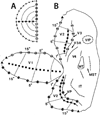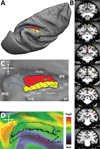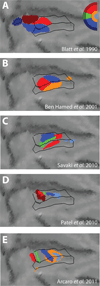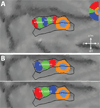Topographic organization in the brain: searching for general principles
- PMID: 24862252
- PMCID: PMC4074559
- DOI: 10.1016/j.tics.2014.03.008
Topographic organization in the brain: searching for general principles
Abstract
The neurons comprising many cortical areas have long been known to be arranged topographically such that nearby neurons have receptive fields at nearby locations in the world. Although this type of organization may be universal in primary sensory and motor cortex, in this review we demonstrate that associative cortical areas may not represent the external world in a complete and continuous fashion. After reviewing evidence for novel principles of topographic organization in macaque lateral intraparietal area (LIP) - one of the most-studied associative areas in the parietal cortex - we explore the implications of these new principles for brain function.
Copyright © 2014 Elsevier Ltd. All rights reserved.
Figures





Similar articles
-
Topographic organization of macaque area LIP.Proc Natl Acad Sci U S A. 2010 Mar 9;107(10):4728-33. doi: 10.1073/pnas.0908092107. Epub 2010 Feb 19. Proc Natl Acad Sci U S A. 2010. PMID: 20173093 Free PMC article.
-
Corticocortical connections of anatomically and physiologically defined subdivisions within the inferior parietal lobule.J Comp Neurol. 1990 Jun 1;296(1):65-113. doi: 10.1002/cne.902960106. J Comp Neurol. 1990. PMID: 2358530
-
The visual parietal areas in the macaque monkey: current structural knowledge and ignorance.Neuroimage. 2001 Jul;14(1 Pt 2):S21-6. doi: 10.1006/nimg.2001.0818. Neuroimage. 2001. PMID: 11373128 Review.
-
Visual Receptive Field Heterogeneity and Functional Connectivity of Adjacent Neurons in Primate Frontoparietal Association Cortices.J Neurosci. 2017 Sep 13;37(37):8919-8928. doi: 10.1523/JNEUROSCI.0829-17.2017. Epub 2017 Aug 11. J Neurosci. 2017. PMID: 28821662 Free PMC article.
-
Multimodal activity in the parietal cortex.Hear Res. 2009 Dec;258(1-2):100-5. doi: 10.1016/j.heares.2009.01.011. Epub 2009 Feb 6. Hear Res. 2009. PMID: 19450431 Free PMC article. Review.
Cited by
-
Post-Attentive Integration and Topographic Map Distribution During Audiovisual Processing in Dyslexia: A P300 Event-Related Component Analysis.Malays J Med Sci. 2020 Jul;27(4):130-138. doi: 10.21315/mjms2020.27.4.12. Epub 2020 Aug 19. Malays J Med Sci. 2020. PMID: 32863752 Free PMC article.
-
Kernel-Regularized ICA for Computing Functional Topography from Resting-state fMRI.Med Image Comput Comput Assist Interv. 2017 Sep;10433:373-381. doi: 10.1007/978-3-319-66182-7_43. Epub 2017 Sep 4. Med Image Comput Comput Assist Interv. 2017. PMID: 29071309 Free PMC article.
-
Tracking and validation techniques for topographically organized tractography.Neuroimage. 2018 Nov 1;181:64-84. doi: 10.1016/j.neuroimage.2018.06.071. Epub 2018 Jul 2. Neuroimage. 2018. PMID: 29986834 Free PMC article.
-
Cerebro-spinal somatotopic organization uncovered through functional connectivity mapping.Imaging Neurosci (Camb). 2024 Sep 5;2:imag-2-00284. doi: 10.1162/imag_a_00284. eCollection 2024. Imaging Neurosci (Camb). 2024. PMID: 40800328 Free PMC article.
-
Effective connectivity in a duration selective cortico-cerebellar network.Sci Rep. 2023 Nov 24;13(1):20674. doi: 10.1038/s41598-023-47954-4. Sci Rep. 2023. PMID: 38001253 Free PMC article.
References
-
- Inouye T. Die Sehstörungen bei Schussverletzungen der kortikalen Sehsphäre: nach Beobachtungen an Verwundeten der letzten japanischen Kriege. W. Engelmann; 1909.
-
- Teuber HL, et al. Visual field defects after penetrating missile wounds of the brain. Harvard University Press; 1960.
-
- Gennari F. De peculiari structura cerebri nonnullis. 1782
Publication types
MeSH terms
Grants and funding
LinkOut - more resources
Full Text Sources
Other Literature Sources

